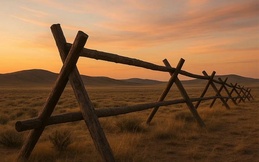Climate Changes, We Don't
Spectator
By Stephen Tuttle | May 17, 2025
As summer approaches, it is time for a quick climate review while information is still available from reliable sources. More than 1,000 employees have been laid off at the National Oceanic and Atmospheric Administration (NOAA), including from the National Weather Service (NWS) from which we get useful information, at least for now.
According to NOAA, 2024 was the warmest on record since accurate records started being kept around 1850. Africa, Europe, North America, and Oceania experienced their warmest year, and South America tied with 2023 for the warmest.
All-time high temperatures were set in parts of India, Africa, and Australia. Here in the U.S., Arizona had 55 days of at least 110 degrees, including a record-breaking streak of 31 consecutive 110-plus days.
In fact, the 10 warmest years since 1850 were the last decade. More troubling, according to the Copernicus Climate Change Service, is that global temperature averages exceeded 1.5 degrees Celsius above pre-industrial levels for the first time, a tipping point we were trying to avoid.
(A brief aside to climate change deniers and those who like to produce temperature charts from tens of millions of years ago, like Joe Rogan. Yes, there was a time when global temperatures were dramatically warmer than they are now or will be any time in our likely future. Those temperature spikes occurred 60 to 100 million years ago. Joe, and others, should take a look at how long it took the planet to achieve those temperatures and the percentage of increase over time. Even going back that far, there has never been a planetary warm-up of this much this fast, and the only difference is human industrialization. According to more than 97 percent of the scientists who study climate, this is not natural and is a long way from normal.)
Additionally, according to the National Aeronautics and Space Administration (NASA), which has also been impacted with a nearly 10 percent reduction in staff, sea levels have increased more and at a faster pace than previously predicted. Some parts of the Caribbean recorded their highest water temperatures ever, a bad sign should hurricanes come calling. Drought continues to bedevil parts of Africa as Ethiopia watches crops wither and die and widespread famine becomes likely.
An increase in extreme weather events has become an annual event. There were 27 such events in the U.S. that did at least $1 billion of damage with a total cost of $182.7 billion in 2024, according to the National Centers for Environmental Information, including 17 severe storms, five hurricanes, two winter storms, one flood event, and one wildfire. Historic rainfall and flooding events are happening in the Southeast and on the East Coast even as this is being written.
The Federal Emergency Management Agency (FEMA) is responsible for helping to repair and restore storm caused damage, but the current administration wants to do away with that agency entirely and leave such work up to the states.
Last year was not our worst in terms of wildfires, according to the National Interagency Fire Center, with fewer than 65,000 fires burning just under nine million acres, about an average year. The rest of the world was less fortunate, with Australia and Europe experiencing devastating fires and record-breaking fires in South America, including an astonishing 279,000 wildfires in Brazil alone.
Fingers are now being pointed, and it should come as no shock in which direction. According to the journal Nature Climate Change, the world’s richest 10 percent have caused two-thirds of climate change since 1990, and the top 1 percent has contributed 20 times more to climate change than the other 99 percent.
Some climate scientists would now like to move the tipping point goal from 1.5 degrees C to 2.0 as a new goal, but others are not at all sure.
Scientists writing in a recently published article in Nature believe we have already lost the battle to mitigate climate change and we should change our emphasis to adaptation. Prevention has failed and mitigation has been too slow and too weak, they believe, so we now have to figure out how to live with a new climate reality.
Cleaner power generation, smarter building techniques, and relocating those about to be inundated by rising sea levels or run out of potable water are some strategies we are going to have to employ soon.
Unfortunately, neither mitigation nor adaptation is likely to come from an administration that denies climate change altogether and wants to increase the extraction and burning of the fossil fuels mostly creating the problems. The “drill baby drill” philosophy—including in the Arctic National Wildlife Refuge—is disastrous, especially since we already get 21 percent of our electric power from renewable sources according to the U.S. Energy Information Administration (which is also on the chopping block).
Climate is still changing rapidly but, so far, we are not.
Trending

13 Spooky Happenings Up North
It’s hard to find a town or village that does not have some sort of Halloween fun planned for residents and visitors. … Read More >>
Thrills & Chills in Cadillac
Cadillac is ready for its Halloween closeup this week! Take the kiddos to the Downtown Trick or Treat on Mitchell Street fro… Read More >>
Howling at the Moon
Your Halloween costume needs one final touch…and Northern Nail Polish has you covered. This Traverse City-based brand… Read More >>


